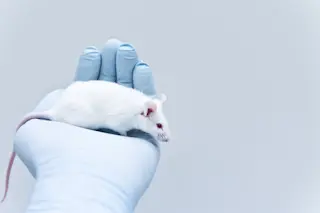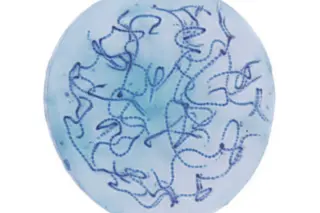Greetings from the flashing, buzzing, control room of Science Not Fiction! Today we kick off our Codex Futurius project, which will strive to answer the kinds of questions that we see keep coming up in science fiction books, shows, movies--and even the occasional musical. We're phrased the questions in the way that a beleaguered author or scriptwriter might pose them, and today's question is: I want Superheroes in my story, all with amazing powers. I also want a good explanation for their origin: could genetic mutation or manipulation create a superhuman?The short answer is yes, within limits. Billions of years of evolution have produced a vast number of abilities in different animals that are beyond the gift of any normal human. Dogs have noses stuffed with olfactory receptors that make them 100 to 1,000 times as sensitive as humans to scents. Fish that swim in the Antarctic Ocean have natural anti-freeze molecules in their cells that allow them to thrive in water that is so cold it would kill a human within minutes. Many insects can see ultraviolet frequencies of light that are invisible to us, giving them a very different view of nature. Because all life on Earth uses the same genetic code, in theory anything that you can find in nature is up for grabs. For example, the blood cells of crocodiles contain a type of hemoglobin that is so efficient at oxygenating a crocodile’s body that the crocodile can lurk underwater for an hour without coming up for air. Researchers have been able to tweak the DNA responsible for producing human hemoglobin to incorporate some of the genetic instructions found in crocodiles, thereby creating more efficient human hemoglobin. This superhuman hemoglobin is currently only produced by bacteria in vats and is intended for medical applications, but in principle it could be engineered into human being, giving them Aquaman-like powers. There are certain physiological limits to what you can borrow, (for example, angel-sized wings on a human being would still be too underpowered to allow him or her to fly. If you really want a character to have working wings, a more radical rearrangement of the superhero’s body plan would be required) but nonetheless scientists have been taking useful traits from one organism and engineering them other organisms for decades now—a famous example is a gene found in the crystal jellyfish that produces a protein that fluoresces, giving off green light. This gene has been used to create “glow-in-the-dark” rabbits, fish, cats, mice and more. You’re not limited to transferring genes between animals either—you can mix and match between bacteria, animals and plants. This technology is known as transgenics, and it was first demonstrated in 1973. It—along with other advances in genetic engineering—so freaked scientists out at the time that they agreed to a voluntary moratorium on any related experiments until an international conference—the Asilomar Conference on Recombinant DNA—was held in 1975 to establish the rules under which research would be conducted. These rules included a list of prohibited experiments that were deemed to be too dangerous as they might result in horrible scenarios, such as the release of deadly new diseases into the wild. The big technical problem with transgenics is getting the desired new genetic material into an organism’s cells. With adult creatures, the techniques of “somatic gene therapy” could be used. In a nutshell, this involves taking a infectious agent, such as a virus, and modifying it to transport the desired new DNA into the subject’s cells. With some agents, known as retroviruses, the new DNA is integrated into the cell’s genome, along with the rest of the cell’s native DNA. This means that as long as the cell is alive, the altered DNA will continue to function, and if the cell divides, the new DNA will be passed onto to its daughter cells. Other methods of delivery do not integrate the new DNA into the cell’s genome, meaning that the effectiveness of the therapy can decline over time, as the host body makes new cells without the modified instructions. Gene therapy is promising in theory, and there have been some early successes in treating genetic diseases, but there also have been some disasters. Cancer is a possible side effect. There is also always the risk of triggering a massive immune response, which is what killed the most famous victim of gene therapy-gone-bad, 18-year-old Jesse Gelsinger. He died of multiple organ failure within four days of receiving an experimental gene therapy intended to treat his liver disease. If you are willing to ignore a lot of laws, you could do away with gene therapy and start with a human egg. Developing an egg fertilized with altered DNA into a baby would automatically mean that every cell in the subject’s body would have the new genetic material, and could pass those genes on to his or her descendants. This situation is analogous to what occurs when a natural mutation arises, and can also give rise to extraordinary abilities. For example, in 2005, DISCOVER reported on a six-year-old boy, dubbed “Superboy” who was born with bulging muscles. By age six, he could easily lift two seven-pound weights with arms held out horizontally. Researchers identified the cause of his super strength as being due to a mutated gene for myostatin, a growth factor that tells muscles when to stop growing. Why not give all our children the gene for superstrength? Or a gene related to higher intelligence? The problem is that when we go beyond treating a disease and trying to enhance humans in this way, we would lose a vast amount of genetic diversity, which would sooner or later come back to bite us in the ass. Genetic diversity is so important to the survival of higher life forms that it prompted the evolution of sex, despite all of the drawbacks and effort involved in trying to find a mate. Sex is a great way to let a species constantly shuffle and recombine DNA from a pool of genes. This helps us keep one step ahead of all sorts of challenges, including pathogens. If we selected a handful of favored genes, and spread them throughout the population at the expense of other genes, we would be at risk of creating a human genetic monoculture. Monocultures are notoriously prone to falling prey to epidemics of disease, as occurred in Ireland in the 19th century when the dominant strain of potatoes turned out to be very susceptible to blight. The resulting famine killed a million people. But what about giving your superhero powers beyond those found in nature, like the ability to shoot a freeze-ray from their hands or telekinesis? There we must step beyond the bounds of pure genetic engineering and start using nanotechnology or cybernetic modifications, both of which will be the subject of future Codex Futurius entries.
Codex Futurius: Creating Superheroes
Explore how genetic mutation or manipulation might create superhuman abilities through science and technology. Discover the potential and risks.
More on Discover
Stay Curious
SubscribeTo The Magazine
Save up to 40% off the cover price when you subscribe to Discover magazine.
Subscribe













